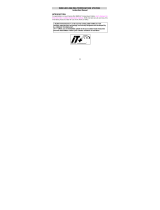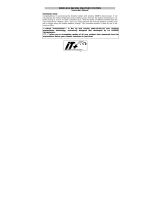
any better (with sunny icon) or worse (with rainy icon)
since the icons are already at their extremes.
The icons displayed forecasts the weather in terms of
getting better or worse and not necessarily sunny or rainy
as each icon indicates. For example, if the current weather
is cloudy and the rainy icon is displayed, it does not mean
that the product is faulty because it is not raining. It simply
means that the air pressure has dropped and the weather
is expected to get worse but not necessarily rainy.
Note:
After setting up, readings for weather forecasts should be
disregarded for the next 12-24 hours. This will allow
sufficient time for the weather station to collect air
pressure data at a constant altitude and therefore result in
a more accurate forecast.
Common to weather forecasting, absolute accuracy
cannot be guaranteed. The weather forecasting feature is
estimated to have an accuracy level of about 75% due to
the varying areas the weather station has been designed
for use. In areas that experience sudden changes in
weather (for example from sunny to rain), the weather
station will be more accurate compared to use in areas
where the weather is stagnant most of the time (for
example mostly sunny).
If the weather station is moved to another location
significantly higher or lower than its initial standing point
(for example from the ground floor to the upper floors of a
house), discard the weather forecast for the next 12-24
hours. By doing this, the weather station will not mistake
the new location as being a possible change in air-
pressure when really it is due to the slight change of
altitude.
WEATHER TENDENCY INDICATOR
The weather tendency indicators (located on the left and
right sides of the weather icons) are working together with
the weather icons. When the indicator points upwards, it
means that the air-pressure is increasing and the weather
is expected to improve, but when indicator points
downwards, the air-pressure is dropping and the weather
is expected to become worse.
Taking this into account, one can see how the weather has
changed and is expected to change. For example, if the






















